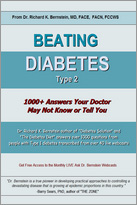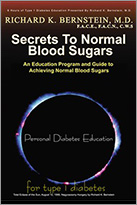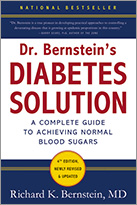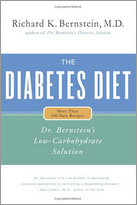INCREASE YOUR AWARENESS OF FOOD CONTENTS
Read Labels
Virtually all packaged foods bear labels that reveal something about the contents. The FDA now requires that labels of packaged foods list the amount of carbohydrate, protein, fat, and fiber in a serving. Be sure, however, to note the size of the “serving.” Sometimes the serving size is so small that you wouldn’t want to be bothered eating it. Beware of labels that say “lite,” “light,” “sugar-free,” “dietetic,” “diet,” “reduced-calorie,” “low-calorie,” etcetera. Counts of calories are only going to tell you so much, and “low fat” is going to tell you nothing about carbohydrate content. “Fat-free” desserts may be the most dangerous of all. Even if you’re losing weight, carbohydrate intake will impede your efforts much more than fat will (see Chapter 9). For example, I’ve found that it’s impossible to put weight on very slim patients following low-carbohydrate diets by giving them 900 extra calories a day in the form of 4 ounces of olive oil. Two recent studies support this—but only if carbohydrate is very limited. They showed that when carbohydrate is low, the fat is metabolized, not stored. “Low-fat” and “fat-free” foods frequently but not always contain more carbohydrate than the foods they replace. The only way you can determine the carbohydrate content is to read the amount stated on the label. But even this can be deceptive. For example, one popular brand of “sugarfree” strawberry preserves has a label that states, “Carbohydrate—0.”
Yet anyone can see the strawberries in the jar, and common sense would tell you that strawberries contain carbohydrate. So deceptive labeling occurs and, in my experience, is fairly prevalent in the “diet” food industry.
Use Food Value Manuals
In Chapter 3, a number of books are listed that show the carbohydrate contents of various foods. These manuals are recommended but not essential tools for creating your meal plan. The guidelines and advice set forth in Chapters 9–11 of this book, plus perhaps the recipes in Part Three, are all you really need to get started.
If you want the potential for considerable variety in your meals, get all the books listed in Chapter 3. The best of these is The NutriBase Complete Book of Food Counts. Food Values of Portions Commonly Used has been the dietitian’s bible for more than fifty years. It is updated every few years. Be sure to use the index at the back to locate the foods of interest. Note that on every page in the main section, carbohydrate and fat content are listed in the same column. The carbohydrate content of a food always appears below the fat content. Do not get the two confused. Also, be sure to note the portion size in all these books. Also very worthwhile is Corrine Netzer’s Encyclopedia of Food Values, which is of similar utility.
If you can find a copy of it, another book, Kosher Calories, by Tziporah Spear (Mesorah Publications, 1985), although out of print, is not just for people whose diets are restricted to kosher foods. More than 10,000 common brand-name foods available in the United States are listed. Also, you can search the USDA’s nutrient database at www.nal.usda.gov/fnic/foodcomp/Data/SR15/sr15.html.
VITAMIN AND MINERAL SUPPLEMENTS
It is common practice to prescribe supplementary vitamins and minerals for diabetics. This is primarily because most diabetics have chronically high blood sugars and therefore urinate a lot. Excessive urination causes a loss of water-soluble vitamins and minerals. If you can keep your blood sugars low enough to avoid spilling glucose into the urine (you can test it with Clinistix/Diastix), and if you eat a variety of vegetables, and red meat at least once or twice a week, you should not require supplements. Note, however, that major dietary sources of B-complex vitamins include “fortified” or supplemented breads and grains in the United States. If you’re following a low carbohydrate diet and therefore exclude these from your meal plan, you should eat some bean sprouts, spinach, broccoli, brussels sprouts, or cauliflower each day. If you do not like vegetables, you might take a B-complex capsule or a multivitamin/mineral capsule each day. See page 175 for a discussion of calcium supplementation for certain people who follow high-fiber or high-protein diets or use metformin.
Supplemental vitamins and minerals should not ordinarily be used in excess of the FDA’s recommended daily requirements. Large doses can inhibit the body’s synthesis of some vitamins and intestinal absorption of certain minerals. Large doses are also potentially toxic. Doses of vitamin C in excess of 500 mg daily may interfere with the chemical reaction on your blood sugar strips. As a result, your blood sugar readings can appear erroneously low. Large doses of vitamin C can actually raise blood sugar and even impair nerve function (as can doses of vitamin B-6 in excess of 200 mg daily). Vitamin E has been shown to reduce one of the destructive effects of high blood sugars (glycosylation of the body’s proteins), in a dose-dependent fashion— up to 1,200 IU (international units) per day. It has recently been shown to lower insulin resistance. I therefore recommend 400–1,200 IU per day to a number of my patients. Be sure to use the forms of vitamin E known as gamma tocopherol or mixed tocopherols, not the common alpha tocopherol, which can inhibit the absorption of essential gamma tocopherol from foods.
CHANGES IN BOWEL MOVEMENTS
A new diet often brings about changes in frequency and consistency of bowel movements. This is perfectly natural and should not cause concern unless you experience discomfort. Increasing the fiber content of meals, as with salads, bran crackers, and soybean products, can cause softer and more frequent stools. More dietary protein can cause less frequent and harder stools. Calcium tablets can cause hard stools and constipation, but this is usually offset if they contain magnesium.
Normal frequency of bowel movements can range from 3 times per day to 3 times per week. If you notice any changes in your bowel habits more or less than these frequencies, discuss them with your physician.
HOW DO PEOPLE REACT TO THE NEW DIET?
Most of my patients initially feel somewhat deprived, but also grateful because they feel more alert and healthier. I fall into this category myself. My mouth waters whenever I pass a bakery shop and sniff the aroma of fresh bread, but I am also grateful simply to be alive and sniffing.




